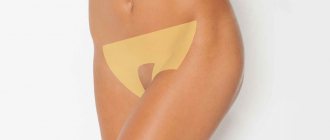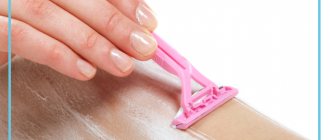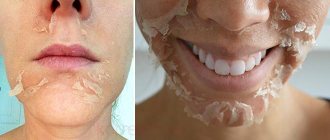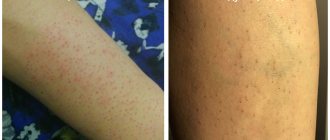From this article you will learn:
- How laser hair removal works
- 4 laser hair removal machines
- Preparing for the laser hair removal procedure
- 7 stages of laser hair removal
- Expected effect and skin care after laser hair removal
- Possible complications after laser hair removal
- Contraindications for laser hair removal
- Do-it-yourself laser hair removal
Care after laser hair removal is very important to obtain the desired effect. If basic rules are not followed, complications may arise in the form of allergic reactions and pain.
To get silky skin in appearance and touch, you need to understand what you can and cannot do after the procedure. In order to enjoy the result, and not eliminate negative consequences, it is important to take into account contraindications and follow the recommendations of a cosmetologist. This is exactly what our article is about.
How laser hair removal works
Laser hair removal is one of the most common and popular cosmetic procedures. The beauty industry produces a great variety of products designed to eliminate unwanted hair. However, after using some drugs and methods (for example, waxing or shaving), the effect does not last long. In addition, the skin often becomes irritated. After laser hair removal, hair disappears forever.
The procedure involves exposing the surface of the skin to light energy through a laser beam. Melanin found in hair follicles absorbs the laser during an hair removal session. The follicle heats up and stops functioning. In addition, there is a blockage of small capillaries that nourish the hair. In just a few sessions of laser skin treatment, you can get rid of growing hairs.
Due to a number of advantages, laser hair removal method is becoming increasingly popular. The advantages of this procedure include:
- high degree of efficiency;
- non-traumatic (even the bikini area will not be affected after laser hair removal);
- long lasting effect;
- no side effects;
- disappearance of ingrown hairs after the first laser hair removal session;
- almost painless removal of vegetation in the shin area (if the need arises, specialists treat the area with anesthetic cream or spray);
- The laser beam can deal with coarse and coarse hair.
The cost of the laser procedure is quite high. But despite this, women in most cases choose this method of hair removal. It allows you to get rid of unwanted vegetation in any area, even the most delicate and tender. According to experts, no allergic reactions occur after the laser hair removal procedure. Therefore, manipulation is not contraindicated for people with even the most sensitive skin.
It must be said that laser hair removal has one disadvantage. The greatest effect can be achieved if there is a contrast in the color of the epidermis and hair.
Red or light-colored hair is not sufficiently receptive to laser beams, unlike tanned and dark skin, which perfectly absorbs melanin from cells. Based on this, we can conclude that laser hair removal is most effective for those with fair skin and dark brown or black hair.
To achieve the ideal condition of your feet, you need to perform several procedures. The laser beam affects only growing hairs. If the bulb is dormant, nothing will affect it. Therefore, repeated sessions are necessary over several weeks. Dormant hair follicles will gradually be destroyed during subsequent treatments.
Numerous clients speak positively about this technique. Cosmetologists consider laser hair removal one of the safest procedures included in the arsenal of the modern beauty industry. The validity period of the result is increased thanks to a gentle method of treating the skin that does not harm it.
Laser hair removal: what is the procedure and how to prepare for it
Some of us try to get rid of unwanted body hair using various means - wax, sugar, tweezers, epilator, razor - and procedures. Some even electrocute themselves using electrolysis. And among this variety of methods, laser hair removal is recognized as the most effective and painless. We understand the intricacies of the procedure together with an expert.
Maria Marusina
Cosmetologist, @dr.marusina
What is laser hair removal
Laser hair removal is a modern, effective and safe method of combating unwanted body hair. The technology is based on the method of selective photothermolysis, which allows you to selectively influence the melanin pigment in the hair shaft and travel down it to the hair follicle, destroying it forever. A new hair is formed from the hair follicle after mechanical removal or loss of the previous one.
The ability of lasers to damage hair follicles was discovered more than 50 years ago. But it was not until 1981 that the theory of selective photothermolysis was proposed by Rox Anderson and John Parrish of Harvard Medical School. A few years later, a group of scientists reported the successful use of ruby laser for long-term hair removal.
@katalina_candezano @angiecouple
All hair on the human body has 4 stages of growth:
- anagen,
- catagen,
- telogen,
- early anagen.
Hair on one area of the skin is in different stages of growth, so it is impossible to remove all the hair at once in one laser hair removal procedure. 10-15% of hair is removed per session. To remove 90% of body hair, it will take 6 to 10 treatments.
Hair color, like the color of our skin and even eye color, is determined by the amount of melanin pigment. Any laser sees exactly the pigment of the hair, so hair that is too light, red or gray will not be seen by any of the existing laser devices.
The darker and thicker your hair (more melanin) and the lighter your skin (less melanin), the better the laser will be able to recognize and remove hair.
Types of lasers
- Ruby (not currently used).
- Alexandrite.
- Diode.
- Neodymium.
How often to do laser hair removal for different areas
The frequency of procedures does not depend on the device, but on the rate of hair renewal in different parts of the body. Recommended intervals between procedures:
- face – 4 weeks;
- arms, armpits, bikini, belly – 4-6 weeks;
- legs and back – 8-10 weeks.
@anyaholdstock @katalina_candezano
Contraindications for laser hair removal
- Pregnancy, lactation.
- Epilepsy.
- Ages up to 18 years only with parental consent.
- Skin damage, inflammation, pigment formations, keloid scars, skin diseases at the epilation site.
- Tattoos at the epilation site.
- Exacerbation of chronic diseases.
- Heat urticaria.
- Herpes is in the acute stage.
- History of oncology.
- Autoimmune connective tissue diseases.
- Hormonal imbalance, which is accompanied by pathological hair growth.
- Excessively tanned skin.
- Taking tetracycline antibiotics, sulfonamides, gold-based drugs or systemic retinoids.
@angiecouple @angiecouple
Possible side effects from laser hair removal
- Redness, itching, crusting, swelling, peeling.
- Burn, blistering.
- Ingrown hairs, development of folliculitis, bruising, abnormal hair growth, ulceration (in rare cases).
- Lightening of freckles and other pigmented formations.
- Hypopigmentation, hyperpigmentation.
- Exacerbation of acne.
- Darkening or lightening of vascular formations.
@angiecouple @angiecouple
Preparing for laser hair removal
For the procedure to be successful, with minimal likelihood of side effects, you should:
- Do not sunbathe or use self-tanning for 1 month before the procedure;
- Do not remove hair using wax, sugar or tweezers for 1 month before the procedure;
- Do not use creams and oils in the laser hair removal area 2 days before the procedure;
- Avoid cleansing, peeling, scrubs and the use of massage brushes 10-14 days before the procedure.
If you decide to undergo laser hair removal, use this checklist.
What you should pay attention to before the procedure
- Laser hair removal must be performed by a medical professional who has been trained to use the specific machine being used.
- You must sign a consent form to perform laser hair removal procedures using this device.
- The medical professional should notify you about the specifics of the procedure, contraindications and possible side effects.
- You should be given glasses that protect your eyes from laser exposure.
- The healthcare professional should ask you to remove any jewelry you have in the treatment area as it may reflect the laser beams.
- There should be no mirrors or other reflective surfaces in the office; windows must be curtained.
About the hair removal procedure
Duration
The duration of the procedure depends on the size of the laser attachment, i.e. on how much skin area it covers with one flash (light spot). The dexterity and experience of the medical professional performing the procedure also affects. Typically, treatment of one area (for example, a total bikini) takes no more than 15-20 minutes.
Pain and anesthesia
The pain of the procedure also depends on the method of cooling the skin during the procedure. Most often this is a jet of cold air or a special cryogenic spray, vacuum, contact cooling with a sapphire tip.
The most ineffective method of cooling is using a watery, cold gel.
Of course, the pain of the procedure is influenced by the amount of hair on the body, the patient’s phototype and individual pain threshold. It is possible to use local anesthetics before the procedure to reduce pain. But the procedure is quite tolerable and much less painful than electrolysis.
However, if you do not experience any sensations at all, then the laser may not have enough power, which will most likely affect the result. The second possible reason is that you have a high pain threshold.
@angiecouple @angiecouple
Rehabilitation after laser hair removal
- There may be redness and swelling around the hair follicle for 1-3 days.
- It is necessary to use SPF 50 protection on open areas of the body where the procedure was performed.
- Do not sunbathe for 1 month after the procedure.
- Do not remove hair (wax, sugar, tweezers) between procedures - only shave.
- Avoid applying acids, scrubs, peelings, and using brushes in this area for 7-10 days.
- Avoid wearing thick synthetic clothing for 2-3 days.
- Exclude visits to baths, saunas, swimming pools and jacuzzi for 3 days.
- Exclude solarium for the entire period of laser hair removal course.
Please note that you should see the first results from laser hair removal after 1-3 procedures. If the amount of hair does not change, and the existing hair does not fall out, then the best option would be to try another device or another clinic.
It is also important to know that we have dormant hair follicles that can awaken throughout life under the influence of external factors and hormonal activity. While the hair is dormant inside the skin, the laser beam cannot have an effect on it. Therefore, it is possible for new hair to appear throughout life even after a successful course of laser hair removal.
@angiecouple @anyaholdstock
Is it possible to do laser hair removal at home?
Home laser hair removal devices have become available in recent years, but there is very little evidence of the effectiveness and safety of such devices, limited to small studies. The use of such devices may be hazardous to health until large independent tests are carried out.
Cost of laser hair removal procedure
Recently, a large number of lasers have become available, and the price range for the procedure varies greatly. We advise you not to go to the first beauty salon near your home, but to study everything carefully and choose a high-quality device and an experienced specialist. A laser hair removal machine is a medical equipment that should only be used in medical institutions. A powerful laser is a very expensive purchase, which increases the cost of the procedure on a high-quality device. When you choose a cheap laser from a beauty salon without a medical license, you risk not only throwing money away and being disappointed with the result, but also endangering your health.
Remember that even the most advanced aesthetic procedures require careful consideration. Take care of your health!
Cover photo: @amandashadforth.
Preparing for the laser hair removal procedure
How can you prepare for the procedure to avoid complications after laser hair removal on your legs:
- 2 weeks before the first session of laser hair removal of the legs, it is necessary to stop all activities aimed at combating unwanted vegetation. In this case, the procedure will be most effective.
- You should not use untried cosmetics for at least 3 days in the area where laser exposure is planned. Otherwise, the skin may unexpectedly react to the new drug, causing hair removal to be postponed.
- At least 2 days in advance, you should not wipe the areas where hair removal will be performed with alcohol solutions. This is necessary so that the water-fat balance of the epithelium is not disturbed, otherwise after the procedure irritation will appear on the skin.
- Immediately before the session, the hair is cut short or shaved. This is necessary to enhance the effect on the follicles.
It is necessary to carefully prepare for the first and subsequent laser hair removal so that there are no complications after it and the effect is maximum.
Recommendations from experts
When talking about whether it is possible to sunbathe before laser hair removal, it is important to understand the specifics of the effects of ultraviolet rays on the skin. After laser hair removal, the skin becomes very sensitive to external irritants.
The fact is that during hair removal, the hair follicle is exposed to a concentrated beam of light, which destroys melanin and deep hair structures. Due to the specific effects on hair, this procedure is most often performed for owners of blond hair. An impressive concentration of melanin can lead to ineffective hair removal.
You should not sunbathe before epilation. Failure to comply with this recommendation can lead to the following consequences:
- The occurrence of burns on the skin as a result of a complex effect on the hair follicles and skin. Damage to the upper layers of the epidermis as a result of the laser can lead to burns;
- Change in pigmentation. As a result of damage to the skin, there is a risk of changes in hypopigmentation or hyperpigmentation;
- Increased dryness and irritation of the skin.
It is important to note that you should not sunbathe 2-4 weeks before hair removal. In addition, the use of artificial tanning creams is prohibited.
Expected effect and skin care after laser hair removal
Clients of beauty salons are often interested in whether there is any effect from laser facial hair removal. To answer this question, you need to compare mechanical shaving and laser treatment. In the first case, the skin may become irritated and the hairs may become stiff. In addition, they need to be shaved regularly and often. The pulse emanating from the laser affects only the hair itself and is absorbed by the color pigment. During hair removal, the skin is not injured, so no cuts are formed and no rash appears. In addition, the result lasts for a long time.
The first procedure removes approximately 40% of the hair. After a full course of laser hair removal, hair grows very slowly, so the results last a long time. Under the influence of a pulsed flash sent by the device, the hair follicle is destroyed. Accordingly, hair growth stops.
Recommended articles on the topic:
- Facial mesotherapy procedure: pros and cons
- Beauty injections: types of drugs, reviews
- Placental therapy is the secret of eternal youth
Experts recommend following simple care rules:
- You should not sunbathe for two weeks after laser hair removal, as harmful ultraviolet rays can cause irritation to the skin.
- It is not recommended to wash your feet in hot water for 3 days to avoid disruptions in skin regeneration processes. In addition, sponges and washcloths with hard bristles should not be used for washing.
- To avoid skin injury, peeling of areas exposed to the laser beam is prohibited. This procedure can provoke infection.
Possible complications after laser hair removal
Advertising brochures often praise laser hair removal, talking about its complete safety and the absence of complications on the skin. Can you believe this? Despite the fact that the procedure is gentle compared to other methods of removing unwanted vegetation, it can cause complications such as:
- skin burns;
- inflammation of hair follicles;
- allergies;
- exacerbation of herpes;
- acute phase of acneiform rash.
Burns can be caused by the following factors:
- very high energy flow is used;
- the wrong procedure technique is used;
- The laser affects hypersensitive areas.
After laser hair removal, an allergic reaction may occur:
- hives;
- severe itching;
- contact dermatitis.
It happens that the skin reacts with allergic rashes in response to care products or anesthetics. It is not recommended to continue the procedure if the cause of the allergy is not clear. After the skin returns to normal, you can continue hair removal sessions. Antihistamines and glucocorticoids (topical forms) are used to treat allergies.
The most common consequence of laser treatment is folliculitis, which appears 2-3 days after the procedure. The cause of this complication is a bacterial infection, which manifests itself in the form of red dots filled with white contents. The skin is irritated and hyperemic. In addition, folliculitis is often accompanied by pain and itching.
If during the hair removal course a woman visited a bathhouse, sauna or swimming pool, the hair follicle may become inflamed.
It happens that this disease is observed in people suffering from hyperhidrosis.
Important aspects of the treatment of folliculitis that appears on the legs after laser hair removal: do not touch the areas of inflammation, do not open the formations, scrubs and other rough means must be avoided. In addition, you need to use only clean towels, do not apply cosmetics to inflamed skin, and wear freshly washed clothes made from natural materials.
The surface of the skin is treated with creams and solutions with an antiseptic effect: Bactroban, Miramistin, chloramphenicol.
If after several days the inflammatory process does not stop or the condition gets worse, you need to consult a doctor for a diagnosis and treatment. You should not take antibiotics on your own.
To avoid complications, it is not recommended to carry out the procedure if there are any contraindications.
Contraindications for laser hair removal
Laser hair removal is not for everyone, although it is effective. It is not recommended if there are any contraindications related to health conditions.
Diseases and restrictions for which laser hair removal of legs is not permitted:
- Acute phase of diabetes mellitus. In this condition, carbohydrate metabolism is disrupted, which leads to the appearance of ulcerations and wounds. In addition, with diabetes mellitus, regeneration of the epidermis occurs much more slowly.
- Taking antibacterial agents. The procedure is allowed only 2 weeks after completion of the course of treatment.
- Carrying out hormonal therapy. During this period, the desired effect may not be obtained, since hormones have a strengthening effect and accelerate hair growth.
- Pregnancy and breastfeeding. In this condition, the woman’s hormonal background changes, and therefore hair removal will be ineffective. The procedure can be performed at the end of lactation.
- Infectious or viral diseases of the skin of the legs. In this case, the laser can cause dangerous complications.
- Tumors of a malignant nature.
- Epilepsy.
- Diseases of the circulatory system.
- Acute phase of pulmonary tuberculosis.
- Acute period of cardiovascular diseases.
Warts and papillomas are a relative contraindication to laser hair removal. Whether or not to perform the procedure in this case is determined by a specialist depending on the individual characteristics of a particular client.
If the skin of the legs is damaged, there are scratches, abrasions, burns, hair removal is not recommended. You must wait until the damage has completely healed. Laser radiation does not affect gray hair, since it contains voids instead of colored melanin. In addition, laser is ineffective on light shades.
What lasers are used
Before you sign up for laser hair removal, you need to study as much information as possible about laser hair removal methods. Unscrupulous salons are able to ignore contraindications for the procedure, so it is necessary to study how to carry it out. The following types of laser hair removal are used in modern salons:
- Ruby laser - used to eliminate dark hair follicles on light skin. In other situations it may lead to the development of burns;
- The Alexandrite laser is used to remove lighter and redder hairs. Not suitable for dark skin;
- Neodymium - used to remove hair of any pigmentation and any skin tone. Due to its high power, the neodymium laser is used only by experienced specialists, sometimes under local anesthesia;
- The diode laser has a less aggressive effect: it is used to treat hair of any shade and has no contraindications for skin tones.
Before you sign up for laser hair removal, you need to study as much information as possible about contraindications for the procedure.
Do-it-yourself laser hair removal
There are two types of laser devices designed for home hair removal: with and without a scanning function. The cost of a conventional device is lower, but the session itself lasts longer. The beam is aimed at each hair separately. One flash of the beam can treat an area of up to 30 mm².
Thanks to the scanning function, the need for precise targeting skills for each specific hair is eliminated. You just need to apply the device to the surface to be treated and leave it for a few seconds. The device can cover areas ranging from 35 mm² to 1 cm² in one flash, depending on the model. Devices with high power are not suitable for depilation at home. Without the necessary skills, you can get burned.
An inexpensive device is also suitable for small areas of skin. However, it is inconvenient and time consuming to process large areas with vegetation using such a device. It is better to buy a laser device that has a scanning function.
Previously, ruby and alexandrite (crystals) were used for depilation. The laser had a short wavelength and low pulse frequency. The procedure using them took longer.
The names of modern devices: diode and neodymium. A safe diode laser hair removal device with excellent characteristics is suitable for home use.
The neodymium laser beam can penetrate deeply. However, without the necessary experience, there is a possibility of damage to skin tissue.
The cost of modern devices is much higher.
To carry out hair removal at home, you should purchase a device equipped with a diode laser. It is considered the most effective device with a low cost, this is the so-called golden mean.
The laser epilator is easy to use. It does not have the same power as a salon machine, so you will avoid burns on your skin. However, professionals advise doing the test on a small area first. The skin surface must first be cleaned and dried. The length of the hairs should not exceed 3 mm. Turn on the device, set the necessary settings and begin to apply it to the skin sequentially. After the flash lasts for a second, move the unit to another area.











